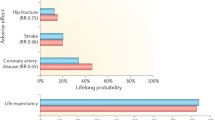Abstract
The effect of estrogen replacement therapy (ERT) and hormone replacement therapy (HRT) for cardioprotection in postmenopausal women remains controversial. Observational studies conducted in the past two decades have suggested an average risk reduction of 50% for the primary prevention of CAD, these findings, however, have not been confirmed by recent randomized clinical trials (RCTs). The discrepancies in results between observational and randomized studies are related to several differences in patient selection, hormone regimen, and biological effect of hormones in different periods of women’s life. In an attempt to justify the use of hormone replacement therapy against the mounting contraindications for any use by several opinion leaders and scientific societies, several authors have criticized the design and the results of the randomized clinical trials as the cause of the unexpected results. The randomized clinical studies were conducted exceptionally well; therefore, methodologic issues are not the problem. The main difference between the observational and randomized studies, which may fully explain the discrepancies between these studies, are the women under study and their reasons for taking hormone therapy. In the observational studies women choose to take ovarian hormones initially for menopausal symptoms and then may have decided to continue for other reasons, while in the randomized studies the absence of menopausal symptoms was a pre-requisite for inclusion in the study. This apparently small difference has important implications because symptomatic women are younger and have clinical symptoms that suggest the lack of estrogen effect on several organs or systems. In conclusion, several biological reasons may have contributed to the divergent findings from observational studies and RCTs. Clearly time elapsed since menopause seems to be an important one for its effect on vascular responsiveness to ovarian hormones and to prothrombotic effects. In the meantime, a role remains for combined estrogen and progestin supplementation in the treatment of menopausal symptoms.
Similar content being viewed by others
References
Stampfer, M., and Colditz, G. (1991). Prev. Med. 20, 47–63.
Sullivan, J. M., Vander Zwaag, R., Lemp, G. F., et al. (1988). Ann. Intern. Med. 108, 358–363.
Wilson, P., Garrison, R. J., and Castelli, W. P. (1985). N. Engl. J. Med. 313, 1038–1043.
Grodstein, F., Stampfer, M. J., Colditz, G. A., et al. (1997). N. Engl. J. Med. 336, 1769–1775.
Falkeborn, M., Persson, I., Adami, H. O., et al. (1992). Br. J. Obstet. Gynaecol. 99, 821–828.
Grodstein, F., Stampfer, M. J., Manson, J. E., et al. (1996). N. Engl. J. Med. 335, 453–461.
Henderson, B. E., Paganini-Hill, A., and Ross, R. K. (1991). Arch. Intern. Med. 151, 75–78.
Mendelsohn, M. E. and Karas, R. H. (1999). N. Engl. J. Med. 340, 1801–1811.
Rosano, G. M., Sarrel, P. M., Poole-Wilson, P. A., and Collins, P. (1993). Lancet 342, 133–136.
Huang, A., Sun, D., Koller, A., and Kaley, G. (2000). Circulation 101, 94–100.
Williams, J. K., Honore, E. K., Washburn, S. A., and Clarkson, T. B. (1994). J. Am. Coll. Cardiol. 24, 1757–1761.
Adams, M. R., Register, T. C., Golden, D. L., Wagner, J. D., and Williams, J. K. (1997). Arterioscler. Thromb. Vasc. Biol. 17, 217–221.
Gerhard, M., Walsh, B. W., Tawakol, A., et al. (1998). Circulation 98, 1158–1163.
Writing Group for the Women’s Health Initiative Investigators. (2002). JAMA 288, 321–333.
Hulley, S., Grady, D., Bush, T., et al. (1998). JAMA 280, 605–613.
Grodstein, F. and Stampfer, M. J. In: Thrombosis and thromboembolism. Goldhaber, S. Z. and Ridker, P. M. (eds.). Marcel Dekker: New York, NY.
Grady, D., Rubin, S. M., Petitti, D. B., et al. (1992). Ann. Intern. Med. 117, 1016–1037.
Grodstein, F., Manson, J. E., Colditz, G. A., et al. (2000). Ann. Intern. Med. 133, 933–941.
Silvestri, A., Gebara, O., Vitale, C., et al. (2003). Circulation 107, 3165–3169.
Scarabin, P. Y., Alhenc-Gelas, M., Oger, E., and Plu-Bureau, G. (1999). Thromb. Haemost. 81, 673–675.
Walsh, B. W., Paul, S., Wild, R. A., et al. (2000). J. Clin. Endocrinol. Metab. 85, 214–218.
Post, W. S., Goldschmidt-Clermont, P. J., Wilhide, C. C., et al. (1999). Cardiovasc. Res. 43, 985–991.
Mikkola, T. S. and Clarkson TB. (2002). Cardiovasc. Res. 53, 605–619.
Herrington, D. M., Espeland, M. A., Crouse, J. R., et al. (2001). Arterioscler. Thromb. Vasc. Biol. 21, 1955–1961.
Herrington, D. M., Reboussin, D. M., Brosnihan, K. B., et al. (2000). N. Engl. J. Med. 343, 522–529.
Hodis, H. N., Mack, W. J., Lobo, R. A., et al. (2001). Ann. Intern. Med. 135, 939–953.
Grodstein, F., Stampfer, M. J., Manson, J. E., et al. (1996). N. Engl. J. Med. 335, 453–461.
Rodriguez, C., Calle, E. E., Patel, A. V., Tatham, L. M., Jacobs, E. J., and Thun, M. J. (2001). Am. J. Epidemiol. 153, 145–152.
Lobo, R. A. (2004). Arch. Intern. Med. 164, 482–484.
Utian, W. H., Shoupe, D., Bachman, G., et al. (2001). Fertil. Steril. 75, 1065–1079.
Archer, D. F., Pickar, J. H., Bottiglioni. F., for the Menopause Study Group. (1994). Obstet. Gynecol. 83, 686–692.
Author information
Authors and Affiliations
Corresponding author
Rights and permissions
About this article
Cite this article
Rosano, G.M.C., Vitale, C. & Lello, S. Postmenopausal hormone therapy. Endocr 24, 251–254 (2004). https://doi.org/10.1385/ENDO:24:3:251
Received:
Revised:
Accepted:
Issue Date:
DOI: https://doi.org/10.1385/ENDO:24:3:251




